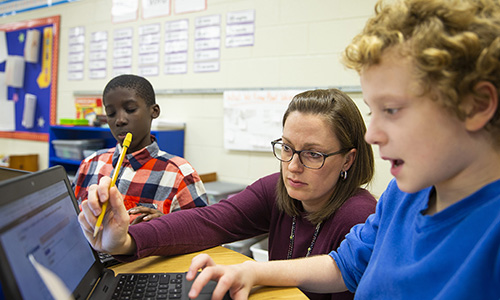 There are places in every content area where formative assessment occurs naturally and most often implicitly. Sports and the arts are two examples where we move from practice to final performance and all the adjustments that occur in-between. Science (experiments) and language arts are two more where we see experiments adjusted based on the results and writing drafted and revised. Having been both a band director and a wood shop teacher in another life, I have a bit of experience with this topic. Recently I read three articles about the explicit and focused use of formative assessment in arts education – art, theater and dance – with some amazing (and not unexpected) results.
There are places in every content area where formative assessment occurs naturally and most often implicitly. Sports and the arts are two examples where we move from practice to final performance and all the adjustments that occur in-between. Science (experiments) and language arts are two more where we see experiments adjusted based on the results and writing drafted and revised. Having been both a band director and a wood shop teacher in another life, I have a bit of experience with this topic. Recently I read three articles about the explicit and focused use of formative assessment in arts education – art, theater and dance – with some amazing (and not unexpected) results.
This summer I’ve been fortunate to meet two folks involved with the arts and incorporating formative classroom assessment. They’ve shared some fascinating and inspiring stories about transforming students (and teachers) through the use of self and peer assessment and feedback. Heidi Andrade often speaks to the power of self and peer assessment. She poses questions like How do we practically apply strategies? How do we get student buy-in for these process and strategies?
Often we make assumptions that students (and teachers) can readily self assess. And while we all may do it every time we walk by a mirror, it isn’t always translated well into the classroom. First, let’s not confuse self and peer assessment with having students grade their own or others’ work. Self and peer assessment is about having students:
- Reflect on the quality of their work
- Judge the degree to which they reflect
- And identify strengths and weaknesses
When we provide students criteria – success criteria – and processes to use, they can generate criteria-referenced feedback for oneself from oneself peer, as well as constructive, criteria-referenced feedback from students for other students. (Andrade 2015).
For example, in Formative Assessment for the Visual Arts, Andrade et al relate the experiences of three teachers. The results of incorporating self and peer assessment along with rubrics generated “improvements in student engagements and the quality of art-making” and “students’ use of lesson specific vocabulary increased” (Andrade et al, (2014) Formative Assessment in the Visual Arts, Art Education P. 35). Who wouldn’t want those results?
In the article Formative Assessment in Theatre Education: An Application to Practice, we discover teachers who used protocols to help their students learn about the criteria, reflect (self and peer assess) and offer feedback, the processes necessary for all participants to be successful with this type of classroom formative assessment.
In Formative Assessment in Dance Education, we learn more about teachers focusing on establishing and getting clear on success criteria so students can generate that criteria-referenced feedback that is necessary for revision. This article also leads into the step that follows getting and using the feedback, which is setting goals, based on the feedback. Moving students forward is the real purpose of feedback, whether from themselves, their peers or from us.
When you read about these arts teachers implementing formative classroom assessment practices, what you are seeing is mini-action research occurring. We know teachers need support (just like our students) when making changes to their practice. Updating our theories, re-negotiating what we do in our daily instructional practice, self assessing and generating feedback are enhanced when we collaborate with our peers. This collaboration, when established on an on-going basis, allows teachers to try something, reflect/self assess, get feedback and make “revisions.” The time to make revisions is key for students generating feedback via self and peer assessments.
Andrade’s mantra is clear and concise: clear criteria, constructive process of critique (feedback), opportunity to revise. If you are willing to incorporate self and peer assessment into your instructional practice, just like these arts teachers discovered, students will learn more, perform better, get better grades and become more self regulated in their learning.
Where are you in moving toward student-centered assessment peer and self assessment? Share your thoughts on our Facebook page or send us a message via Twitter (@NWEA).




